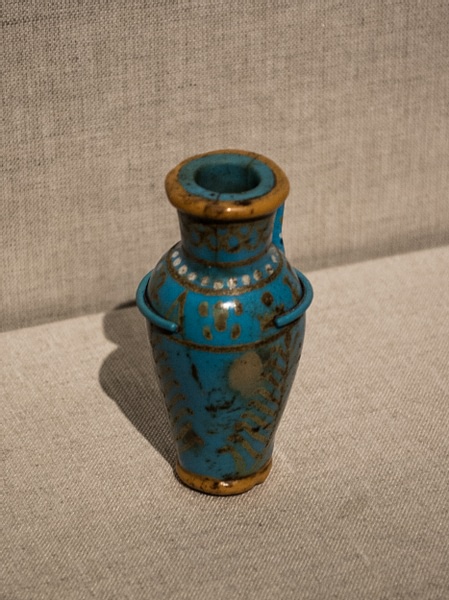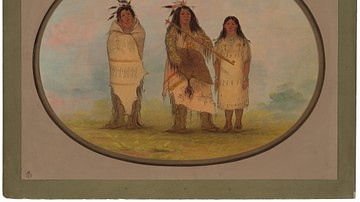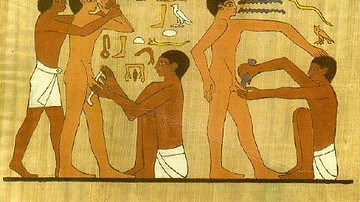For the ancient Egyptians life was a celebration, and so, just as one would want to look one's best at any party, personal hygiene was an important cultural value. The Egyptians bathed daily, shaved their heads to prevent lice or other problems, and regularly used cosmetics, perfumes, and breath mints. So important was one's personal appearance that some spells from The Egyptian Book of the Dead stipulate that one cannot speak them in the afterlife if one is not clean and presentable, and it is clear this means in a physical sense.
Spell 125 prohibits one from speaking it unless one is "clean, dressed in fresh clothes, shod in white sandals, painted with eye-paint, anointed with the finest oil of myrrh." The gods are regularly depicted wearing eye make-up, as are the souls in the afterlife, and cosmetics are among the most common items placed in tombs as grave goods.
Cosmetics were not only used to enhance personal appearance but also for one's health. The ingredients used in these ointments, oils, and creams helped to soften one's skin, protect from sunburn, protect the eyes, and improve one's self-esteem. Cosmetics were manufactured by professionals who took their work quite seriously since their product would be judged harshly if it were not the best it could be; such a judgment would result not only in a loss of reputation in the community but the possibility of a poor reception by the gods in the afterlife. To make sure they provided the best they could, ancient Egyptian manufacturers relied on the finest natural ingredients and most trusted production methods.
The science behind Egyptian cosmetics, deodorants, breath mints, and toothpaste was so advanced that, according to the Oxford English Dictionary, the English word 'chemistry' (derived from 'alchemy') has its ancient roots in Kemet, the ancient name of Egypt in the Egyptian language (the name 'Egypt' is a Greek term). In his article on Medicine in Ancient Egypt, Dr. Sameh M. Arab supports this etymology and explains how, in spite of their shortcomings, Egyptian physicians had the most comprehensive knowledge of medicines in the ancient world. This same expertise is evident in the Egyptian manufacture of cosmetics, perfumes, and other aspects of personal hygiene.
Daily Use of Cosmetics
Cosmetics were used from the Predynastic Period in Egypt (c. 6000 - c. 3150 BCE) through Roman Egypt (30 BCE-646 CE), the entire length of ancient Egyptian civilization. Men and women of all social classes applied cosmetics, although, clearly, the better products could only be afforded by the wealthy. These cosmetics were manufactured professionally and sold in the marketplace, but it seems some of lesser quality could be made in the home.
A morning ritual, after one rose from bed, would be to bathe. Every household, no matter the class, had some form of a basin and jug used for washing the hands and showering. There were also foot baths, made of stone, faience, ceramic, or wood, for washing the feet. These were mass-produced during the First Intermediate Period of Egypt (2181-2040 BCE) as single-foot and double-foot baths.
One would wash one's hands, face, and feet before and after meals, before bed, and upon rising in the morning. Priests were expected to bathe more regularly, but the average Egyptian took showers and baths on a daily basis. In the morning, after one had washed, came the application of a cream, the ancient equivalent of sunblock, to the body, and then one would apply make-up, derived from ochre and sometimes mixed with sandalwood, to the face. Egyptologist Helen Strudwick writes:
In ancient Egypt, the focus was on the eyes, which were outlined with green or black eye paint to emphasize their size and shape. The ground pigments of green malachite, mixed with water to form as paste, were used until the middle of the Old Kingdom but were then replaced by black kohl, produced from the mineral galena, which came from the mountain regions of Sinai. Significantly, kohl had therapeutic value in protecting the eyes from infections caused by sunlight, dust, or flies. (380)
Kohl was created by grinding the natural elements of galena, malachite, and other ingredients into a powder and then mixing them with oil or fat until one produced a cream. This cream was then stored in stone or faience pots which were kept in a case of wood, ivory, silver, or other precious metal. Some of the most elaborate items found in tombs and the ruins of homes and palaces are these kohl cases which were intricately carved works of art. Kohl was quite expensive and only available to the upper classes, but it seems the peasant class had their own, cheaper, variant of the cosmetic. How this was manufactured, or from what chemicals, is unclear.
Creams, oils, and unguents were also used to preserve a youthful appearance and prevent wrinkling. They were applied with the hand, brushes, and in the case of kohl, a stick. These applicators, along with cosmetic spoons, are frequently found as grave goods. Honey was applied to the skin to help heal and fade scars, and crushed lotus flowers and the oil from various plants (such as the papyrus) were used in making these applications. In addition to the health benefits of protecting the skin from the sun, these cosmetics seem to have warded off sand flies and other insects.
Unguents were kept by the wealthy in ornate jars which were often as intricately designed as the kohl cases. A particularly popular design was a jar in the form of Bes, the god of fertility, childbearing, children, and joy. Unguents would be rubbed all over the body and especially sweet-smelling and potent mixtures under the arms and around the legs.
As most Egyptians went barefoot, they would also rub an ointment on their feet, especially the soles, which acted as an insect repellent as well as sunscreen. For the king and the upper class, manicurists were employed to take care of one's finger- and toenails, which was done with a small knife and file. The manicurist to the king was a prestigious position, and these men always included their job title prominently on their tombs.
How the peasant class handled manicures and pedicures is not recorded, but most likely, they followed the same course only with less sophisticated tools or servants. The general life of the peasant class is fairly well documented, but not the specifics. Peasant farmers and their families would also have applied creams, ointments, and some form of deodorant but would not have been able to afford most perfumes.
Perfumes & Deodorants
The most popular and best-known perfume was kyphi. It was made of frankincense, myrrh, mastic, pine resin, cinnamon, cardamom, saffron, juniper, mint, and other herbs and spices. The scent is described as completely elevating, and those who could afford it are reported as being envied by those who could not. Strudwick notes that "the Egyptians loved sweet, spicy perfumes that filled the air with their heady, long-lasting aroma," and kyphi was the most expensive and sought-after of these (378).
The ingredients for kyphi came largely from the land of Punt and so were rare in Egypt. There are only a few expeditions to Punt mentioned in Egyptian history aside from the famous trip commissioned under queen Hatshepsut (1479-1458 BCE). Whether the Egyptians were able to replicate these ingredients on their own is unknown, but it seems unlikely. Kyphi was so rare and expensive that it was primarily used in temples as an incense burned for the gods.
Less expensive and more common perfumes were made from flowers, roots, herbs, and other natural elements, which were ground into a paste and then either combined with fat or oil for a cream or made into a cone of incense. Paintings and inscriptions often depict ancient Egyptian men and women wearing these cones on their heads at parties and festivals, but there is considerable doubt as to whether they walked around with burning incense attached to their wigs.
No evidence of incense or fat residue has been found on any extant wigs from ancient Egypt, and it seems improbable they would have tried to balance a cone of incense at festivals where it was common to drink to excess. Most likely, the depictions of the people with the cones on their heads symbolize the good times had at such events or, perhaps, that the event had included sweet-smelling incense. There is also the possibility, however, that Egyptians did wear these incense cones on their heads at gatherings.
Deodorants were made in the same way as perfumes and often they were the same recipe applied in the same way. A number of recipes for deodorants, however, were for less fragrant products than a perfume. One method listed was to mix an ostrich egg, nuts, tamarisk, and crushed tortoise shell with fat, mix into a cream, and apply to one's arms, torso, and legs for a scent-free deodorant. A recipe and prescription from the medical text known as the Hearst Papyrus recommends mixing lettuce, myrrh, incense, and another plant (whose name is not known) and rubbing the paste on the body to prevent the odor of perspiration. The juices from fruits, mixed with frankincense or other spices such as cinnamon were also used.
Wigs, ToothPaste, & Breath Mints
Before one left the house for the day, one would put on one's wig and clean one's teeth. Wigs, as noted, were worn to prevent lice, but they also were simply more comfortable in the arid climate and made personal hygiene easier. Wigs were made of human hair until the Second Intermediate Period of Egypt (c. 1782 - c. 1570 BCE) when the Hyksos introduced horses into Egypt; afterwards, horse hair was used in wig manufacture as well as human hair.
Wigs were made in different styles to be worn on separate occasions. It was recognized that one might wear their hair differently to a family gathering than to a fashionable event or festival, and wigs were designed differently to meet this need. As in all other areas of Egyptian life, the wealthy could afford the best wigs which were sometimes braided with jewelry or fine gems and perfumed. Poorer people of the lower classes wore wigs woven from papyrus plants or shaved their heads and simply wore a head covering.
In cleaning one's teeth, one would use the Egyptian invention of the toothbrush and toothpaste. Toothpaste was invented before the toothbrush, and evidence of its use dates back to the Predynastic Period. The ingredients of the earliest toothpaste are not known, but a later recipe calls for a mixture of mint, rock salt, pepper, and dried iris flower. This would have been ground into a powder and applied to the teeth; one's saliva would have turned it into a paste. The toothbrush was, at first, a stick with one end frayed to a brush-like fan. Eventually, this developed into a notched stick with thin strips of cut plant (most likely papyrus) tightly bound into the notch as bristles.
Throughout the day, to keep one's breath fresh, one would suck on breath mints. These were made both commercially and at home by mixing frankincense, cinnamon, melon, pine seeds, and cashews together, grinding them into a powder, and then adding honey. The honey would serve as a binding ingredient which, when fully mixed with the rest, was heated over a fire, left to cool slightly, and then formed into small candies. It is probable that some of the jars and bowls found in homes were candy dishes which held these mints.
When one returned to the house at night, one would remove one's wig and bathe to remove one's make-up before the evening meal. From morning to evening, cosmetics and personal hygiene were a part of every ancient Egyptian's daily rituals. Since a primary goal of one's life was to make one's personal existence worthy of eternity, care for one's physical appearance and health was a priority.
The Egyptians may have had the most ideal vision of the afterlife but there is no record of any of them in any particular hurry to get there. Even so, life as an eternal journey was the accepted understanding of Egyptian culture. Applying cosmetics, as well as the use of other means of maintaining one's health and appearance, was necessary not only for a more pleasant time on earth but for the soul's eternal form in the next phase of existence.









